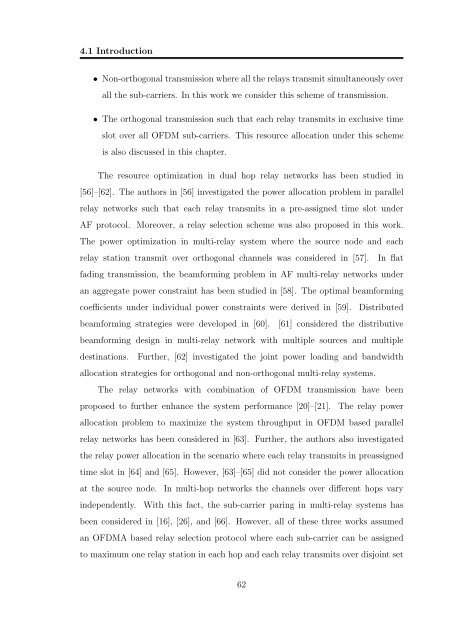Resource Allocation in OFDM Based Wireless Relay Networks ...
Resource Allocation in OFDM Based Wireless Relay Networks ...
Resource Allocation in OFDM Based Wireless Relay Networks ...
Create successful ePaper yourself
Turn your PDF publications into a flip-book with our unique Google optimized e-Paper software.
4.1 Introduction<br />
• Non-orthogonal transmission where all the relays transmit simultaneously over<br />
all the sub-carriers. In this work we consider this scheme of transmission.<br />
• The orthogonal transmission such that each relay transmits <strong>in</strong> exclusive time<br />
slot over all <strong>OFDM</strong> sub-carriers. This resource allocation under this scheme<br />
is also discussed <strong>in</strong> this chapter.<br />
The resource optimization <strong>in</strong> dual hop relay networks has been studied <strong>in</strong><br />
[56]–[62]. The authors <strong>in</strong> [56] <strong>in</strong>vestigated the power allocation problem <strong>in</strong> parallel<br />
relay networks such that each relay transmits <strong>in</strong> a pre-assigned time slot under<br />
AF protocol. Moreover, a relay selection scheme was also proposed <strong>in</strong> this work.<br />
The power optimization <strong>in</strong> multi-relay system where the source node and each<br />
relay station transmit over orthogonal channels was considered <strong>in</strong> [57]. In flat<br />
fad<strong>in</strong>g transmission, the beamform<strong>in</strong>g problem <strong>in</strong> AF multi-relay networks under<br />
an aggregate power constra<strong>in</strong>t has been studied <strong>in</strong> [58]. The optimal beamform<strong>in</strong>g<br />
coefficients under <strong>in</strong>dividual power constra<strong>in</strong>ts were derived <strong>in</strong> [59]. Distributed<br />
beamform<strong>in</strong>g strategies were developed <strong>in</strong> [60]. [61] considered the distributive<br />
beamform<strong>in</strong>g design <strong>in</strong> multi-relay network with multiple sources and multiple<br />
dest<strong>in</strong>ations. Further, [62] <strong>in</strong>vestigated the jo<strong>in</strong>t power load<strong>in</strong>g and bandwidth<br />
allocation strategies for orthogonal and non-orthogonal multi-relay systems.<br />
The relay networks with comb<strong>in</strong>ation of <strong>OFDM</strong> transmission have been<br />
proposed to further enhance the system performance [20]–[21]. The relay power<br />
allocation problem to maximize the system throughput <strong>in</strong> <strong>OFDM</strong> based parallel<br />
relay networks has been considered <strong>in</strong> [63]. Further, the authors also <strong>in</strong>vestigated<br />
the relay power allocation <strong>in</strong> the scenario where each relay transmits <strong>in</strong> preassigned<br />
time slot <strong>in</strong> [64] and [65]. However, [63]–[65] did not consider the power allocation<br />
at the source node. In multi-hop networks the channels over different hops vary<br />
<strong>in</strong>dependently. With this fact, the sub-carrier par<strong>in</strong>g <strong>in</strong> multi-relay systems has<br />
been considered <strong>in</strong> [16], [26], and [66]. However, all of these three works assumed<br />
an <strong>OFDM</strong>A based relay selection protocol where each sub-carrier can be assigned<br />
to maximum one relay station <strong>in</strong> each hop and each relay transmits over disjo<strong>in</strong>t set<br />
62

















